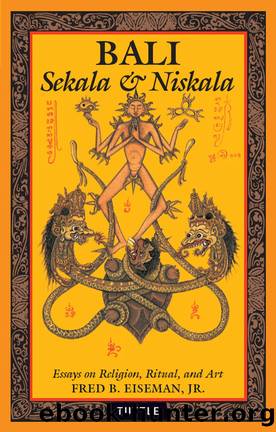Bali by Fred B. Eiseman

Author:Fred B. Eiseman
Language: eng
Format: epub
ISBN: 978-1-4629-0092-3
Publisher: Tuttle Publishing
THE SASIH
1. Kasa 7. Kepitu
2. Karo 8. Kaulu
3. Ketiga 9. Kesanga
4. Kapat 10. Kedasa
5. Kelima 11. Jiyestha
6. Kenem 12.Sadha
The actual lunar cycle, from one new moon to the next, takes slightly more than 29-1/2 lunar days, not the 30 specified by the Saka calendar. If 30 solar days corresponded to 30 lunar days every month the observed full and new moons would not coincide with the calendric full and new moons â the phases would appear half a day earlier every month, an error that would quickly throw the calendar noticeably off. Yet the calendar prescribes 30 lunar days in a lunar month.
To keep this error from accumulating, the Saka calendar incorporates an adjustment. Every 9 weeks â 63 days â 2 lunar days are made to fall upon a single solar day. Such a day is called ngunalatri, from the Sanskrit for "minus one night." The paper calendar indicates this day by printing 2 lunar day numbers, separated by a slash, to the right of the date number. Currently this double lunar day is set always to fall on a Wednesday. If you look at the calendar and run horizontally along a Buda/Wednesday line, you will find such a ngunalatri every 9 weeks. In the past, the ngunalatri did not always fall on a Wednesday, and it may not do so in the future. According to the officials at the Department of Religion in Denpasar, and according to those at the Central Hindu Dharma Committee, the ngunalatri day of the week should change every century. It did not change at the end of the Saka 19th century in 1979, but serious consideration is being given to changing it now.
Determining past practices in the formulation of Balinese calendars is extremely difficult. Only one reasonably complete collection of old calendars exists in all of Bali, at the Gedong Kertya lontar library in Singaraja. The collection dates back to 1935, but there are several gaps, and most of the early calendars contain unintelligible symbols, omissions, and abbreviations with no standards of nomenclature. From these records I found that the ngunalatri was observed in the past sometimes on Wednesday, sometimes on Sunday or Tuesday, and sometimes on several different days of the week in one year. (An aside: Strangely enough, the year 1963 is missing. That was the year that Gunung Agung, Bali's sacred and highest volcano, erupted during the Eka Dasa Rudra ceremony, killed hundreds, and nearly destroyed the most important temple in Bali.) In any case, it is obvious that until recently there was no standardization. For example, according to these old calendars, North Bali had its full and new moons a day earlier than South Bali.
The calendars become more or less decipherable in the year 1955. This is the first year that the calendar was compiled by I Ketut Bangbang Gede Rawi. This is the man whose photograph, taken some years ago, adorns every page of the most common calendar. But when I visited him in Celuk, I could not extract any useful information from him.
Download
This site does not store any files on its server. We only index and link to content provided by other sites. Please contact the content providers to delete copyright contents if any and email us, we'll remove relevant links or contents immediately.
Kathy Andrews Collection by Kathy Andrews(11708)
The remains of the day by Kazuo Ishiguro(8788)
Paper Towns by Green John(5065)
Spare by Prince Harry The Duke of Sussex(5054)
The Body: A Guide for Occupants by Bill Bryson(4953)
Industrial Automation from Scratch: A hands-on guide to using sensors, actuators, PLCs, HMIs, and SCADA to automate industrial processes by Olushola Akande(4915)
Machine Learning at Scale with H2O by Gregory Keys | David Whiting(4106)
Be in a Treehouse by Pete Nelson(3924)
Never by Ken Follett(3762)
Harry Potter and the Goblet Of Fire by J.K. Rowling(3759)
Goodbye Paradise(3710)
Into Thin Air by Jon Krakauer(3289)
The Remains of the Day by Kazuo Ishiguro(3280)
The Cellar by Natasha Preston(3242)
The Genius of Japanese Carpentry by Azby Brown(3209)
Fairy Tale by Stephen King(3193)
120 Days of Sodom by Marquis de Sade(3161)
The Man Who Died Twice by Richard Osman(2979)
Drawing Shortcuts: Developing Quick Drawing Skills Using Today's Technology by Leggitt Jim(2975)
